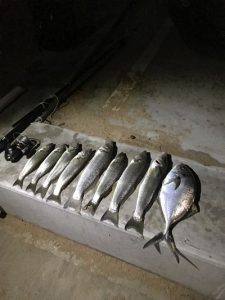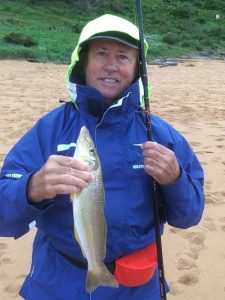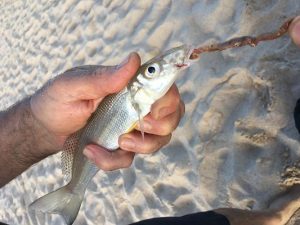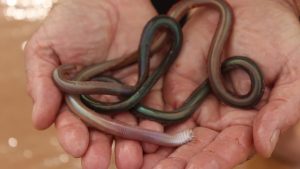Fishing for Whiting at the Beach
Nov 02, 2021
Whiting Fish
Beach Fishing For Sand Whiting
There are several members of the Whiting fish Sillaginidae family that abound in Australian coastal waters.
This is a target species article focused specifically on fishing for Sand Whiting off the beach.
I know how important detail is to achieve success, however, I will try to keep this instruction simple.
My goal is to make it easy for you to understand and also give you the best information possible on this subject.
INTRODUCTION
In this article, I am going to share secrets that I have learned from decades of fishing for Whiting off the beach. I will teach you how I consistently catch Whiting all year round.
Fishing for Sand Whiting off the beach is one of the great Aussie fishing experiences.
Sand Whiting are one of the most eagerly sought after fish species by beach fishos all along the east coast of Australia from Eden to Cape York.
Whiting fishing is easy to learn and reaps great rewards.
Australia is blessed with an expansive coastline of pristine sandy beaches, which are home to the humble Whiting Fish.
Beach fishing is safe and can be enjoyed by the whole family. I have spent many days on the beach with my wife and kids fishing for whiting, I love it, and I think that I will be fishing for Whiting off the beach for as long as I can still walk down to the sand.
I am excited to share this information with you. It is such great fun.
My buddy Phil fishing the edges of a deep gutter
The are a number of factors that influence where and when to fish for Sand Whiting off the beach.
WEATHER AND OCEAN CONDITIONS
Fish when the conditions are good. You will have more fun and catch lots of fish.
Don’t waste your valuable time in poor conditions. Specifically, howling winds and massive surf etc, etc.
Wave Action
Breaking waves, turbulence and water movement are important for Whiting fishing, and also most other fish species that you can catch in the surf. Specifically, in the case of Whiting, waves breaking on sand bars and on the edge of the shore stir up the sand and reveal food for the searching Whiting.
White water created by breaking waves also offers the Whiting protection from large predators.
Big Waves
I see beach fishing as a relaxing lay back style of fishing. It is most enjoyable when the waves are not too big and the sea is not too rough.
Heavy seas create strong currents and drag, which can make fishing difficult.
You want your bait to stay in the best spot. It can be very frustrating, if each time you cast your line out within seconds it ends up being swept down the beach.
Using a big star sinker can help but it is not ideal.
It is best to avoid fishing for Whiting off the beach in rough weather.
Calm Seas
Calm weather produces it’s own challenge when chasing Whiting off the beach.
The absence of breaking waves stirring up the sand and revealing food for the fish, limits the areas of the beach that will be productive.
Often during a period of flat swell the ocean can look like a lake.
On days like this the water just laps upon the edge of the beach. There are no features or structure like sand bars and gutters to cast towards and prospect for fish.
Casting into deep water with no structure is often a waste of time.
The best option in calm weather is to cast your bait right near the waters edge. Cast close to shore because the Whiting will be patrolling the edge looking for food. The fish are often so close to shore in these conditions that you could actually use a hand line.
Another good choice in calm weather is to fish right at the end of the beach near the headland where the sand meets the rocks. Whiting regularly patrol the edge of the sand and the rocks looking for food.
Eight Sydney Whiting to 40 cm and one Trevally 1/12/17
The Best Wave Conditions
Generally, a swell size of half a meter to 1.5 meters is best when targeting Sand Whiting.
This size swell creates plenty of structure in the surf and stirs up plenty of food for hungry fish. Accompanied with no wind or a light breeze these conditions make for great fishing.
A small to medium-sized star sinker is usually all that you need to hold your position.
For many years when fishing for Whiting off the beach I used various sized ball sinkers. The ball sinkers tend to roll around in the surf. The theory is that if your bait moves around a bit you cover more ground and therefore may get more bites.
After years of experience, I no longer believe that using a running ball sinker is the best Whiting fish rig.
I now use star sinkers to hold my position and have consistently great results. This is also better for throwing out a bait and putting it in a rod holder as a set line while you fish with a second rod.
Wind
No wind or a light breeze is perfect for fishing. I don’t mind some breeze, it can be good especially if the sea is flat.
Strong winds make life more difficult. Strong winds cause a bow in your line, which makes it harder to feel bites. They can also whip up a current and add to drag.
If there are strong winds it is best to fish at the protected end of the beach. Depending on the direction of the wind, there is usually one end of the beach that is protected.
For example, on the East Coast if there is a Northwind you should seek protection from the wind at the North end of the beach close to the headland.
Go to the South end of the beach in the South wind. If the wind is westerly or straight offshore it doesn’t matter, you can fish anywhere.
Bright Sun Vs Clouds and Rain
This is an interesting one.
Generally, during daylight hours I have had my best catches when the weather is cloudy and overcast. I love fishing when it is cloudy with light rain.
Often on sunny days once the sun has risen above the horizon, the Whiting fish go off the bite.
I definitely prefer cloudy weather during the day.
However, having said that, recently I went beach worming on a bright sunny day with crystal clear water at low tide and threw out a line while I was catching worms. Every time my bait hit the water I caught a fish!
I also read a blog where a guy said he likes bright sunny days. I still prefer cloudy days but it just goes to show, the fish can be there any time and when you don’t expect them.
If you have time to go fishing and the weather is OK just go. The main thing is to have a line in the water.
LOCATION
Many people ask this question. When I go to a beach where is the best place to catch Whiting? How can I find them?
As their name suggests they live on the sandy areas of our coastline.
You can catch Sand Whiting along the entire length of a beach from one rocky headland to the next. However, depending on the structure and weather conditions at a beach, Whiting will be more highly concentrated in certain areas.
It is our goal to fish the areas of the beach that have the most fish.
My motivation is always to catch fish and be successful. I have a strong hunting instinct and like to analyze and strategize each fishing session. I fish with purpose.
Check your local beaches regularly to see where the best fishing spots are.
This is something that I really enjoy doing. I am always thinking of having a fish and it is exciting to see what is happening down at the beach. Most days I drive up to the beach and check out the conditions.
When I know that I am going to go fishing I always have a look at a couple of beaches to find good fishing options.
HOW TO READ A BEACH
Typical Beach Formation showing Sand Bars and 2 Deep Gutters
Whiting patrol up and down a beach in search of food. The whiting will be where their food source is, so our focus is to fish the areas where we believe the Whiting will be feeding.
Whiting feeds on worms, small crustaceans and bivalve molluscs such as pipis that live in or on the seafloor. They also feed on pieces of dead squid and fish that fall onto the sand bottom.
We look for places where waves break on the sand stirring up the bottom and revealing food for the whiting. Rips or Eddies also concentrate food and indicate where Whiting may be lurking..
Let’s look at a couple of scenarios.
Scenario 1.
When the surf is flat and there is no structure on the beach (no sand bars, gutters etc), the fish will be right near the shore along the edge of where the waves break on the beach. This could be as little as 2 meters from the shore. In this situation, a very small cast is needed, really just a light flick of the rod. The Whiting will be sniffing along the edge where the sand is stirred up. You don’t need a big beach rod on days like this.
Scenario 2.
Let’s say there is a swell about 1 meter in height and the beach has a great structure with a series of sandbars and deep gutters.
Choose the places where a wave washes off a sandbar into a gutter and fish along this edge.
Waves break on a sandbar and rumble across the shallow sandy area until they reach deep water where they become a swell again until they reach the shore.
When a wave breaks on a sandbar it stirs up the sand and can reveal any worms, crabs, and other creatures that live there. These fish foods are then swept along the sandbar with the wave and off the sand bar into the edge of the deep water/gutter where hungry fish will be searching for food.
A Sandbar is a shallow area of water where the waves break consistently because it is shallow. A Gutter, also known as a Rip by lifesavers, is where the water washed in by waves breaking on Sandbars drains back out to sea creating a deep channel.
Prospecting
Having discussed the parts of a beach where you are most likely to catch fish it is important to note that prospecting plays a big part in locating the fish.
By prospecting, I mean casting into different areas until you locate the fish.
Don’t keep casting into the same spot if you are not getting any bites.
I will cast at specific structure or I will first put in a long cast and gradually work my bait back towards the shore until I locate where the fish are.
You want to find the fish. Once you get some action, keep casting into that same area. Searching for the fish is all part of the fun and makes fishing interesting.
Fish also move with the tide. You can be catching fish one after the other and then it goes quiet. Try casting up onto a sandbar or down into the deeper water until you locate the fish again.
Check out this video I made on Beach Fishing with worms.
TIDES – TIME OF DAY – SEASONS
Tides
I fish for Whiting when I have the time regardless of tide and find that you can catch them at any stage of the tide.
The bottom half of the run in tide, up to about the 4th hour of the run in, is the premium time to fish for Whiting off the beach. The fish will be moving in to the gutters to feed and the gutters are more easy to see. Whiting tend to be concentrated where the water runs off the sand bars washing food into the gutters.
On high tide Whiting can be more spread out and will move up on to the sand bars in search of food.
At low tide, if there is no depth of water in the gutters, put on a larger sinker and cast out just behind the main breaking waves.
I have caught many fish employing this tactic.
You may need to walk out on to a sand bar or wade out into the water a bit in order to cast beyond the waves. In summer it doesn’t matter if you get a bit wet, just wear a pair of shorts and a t-shirt.
In summary, focus on the premium times but know that you can catch fish at all stages of the tide.
Time of day
Time of day is more critical than tide.
It is generally accepted that periods of low light such as the early morning or late afternoon up until dark are the best times to catch Whiting from the beach.
From experience, the middle of the day when the sun is bright and the water is clear, is usually not the best time to fish. Sunburn is also a concern at this time of the day.
However, if there is a reasonable swell running, creating white water and stirring up the sand, the Whiting fishing can be good all day.
Overcast or rainy conditions are also great for fishing all day.
Results of a morning fish before work.
Phil with a cracking Sand Whiting
Seasons
Sand Whiting can be caught all year round.
I fish for Whiting all year round and catch good numbers of them consistently.
Whiting are around in greater numbers during the warmer months as they travel in to the estuaries to spawn. November through to March is the peak period.
More people fish in summer because the weather is warmer, so plenty of fish are caught in summer.
In Sydney, where I live, a lot of guys who like to target Whiting off the beach fish heavily for them from late October through Christmas and into the new year.
WHITING FISH TACKLE
Rods, Reels, and Line
I’m not necessarily a purist when it comes to this subject. I am more of a practical fisherman. The reality is that various styles of rods and reels will do the job well and you may already own some rods and reels that will work well.
Sidecast and Spinning reels are both suitable, however I prefer a Spinning reel for the faster retrieve.
Monofilament fishing line ranging from 4kg to 6kg is perfect. You can use lighter line but I don’t think that it is necessary.
When I am fishing for Whiting off the beach, depending on the conditions, I like to have an outfit for making long casts and an outfit for making short casts. Often I will take 2 rods with me. The larger outfit I cast out as a set line, I then prospect close to shore with my light line. Both are extremely effective.
Whiting often swallow the hook, so you can relax with your set line because the fish usually hook themselves.
Outfit 1 – for calm days fishing close to shore
Small rod about 7 feet in length rated 2 – 4kg
Spin reel 1000 – 2500 series spooled with 3 – 4 kg nylon line.
Flourocarbon leader 10lb.
Outfit 2 – for larger swell or reaching good ground further out
Light 10 – 12 foot beach rod.
Spin reel 4000 series spooled with 6kg nylon line.
Flourocarbon leader 10lb.
Whiting Rig
Let’s keep it simple.
I am going to show you my best Whiting Rig ever. Plus one other simple rig that I have used for years that catches lots of fish.
One is quick to get ready while the other takes a bit longer to set up.
The only variable with either rig is the size of the sinker which needs to be adjusted based on the surf conditions.
Being well prepared makes fishing more enjoyable. It is a good idea to pre-make some rigs while you are watching the TV at home. When you get to the beach you just have to tie the rig on an you are fishing straight away.
Rig 1
First thread a ball sinker on to your main line
Tie on a size 6 swivel
Attach a 10lb fluorocarbon leader 50cm in length
Tie on a size 2 long shank hook
This undersized Whiting easily gulped a size 2 long shank hook.
Rig 2
THIS IS MY BEST WHITING RIG
BEST BAITS FOR WHITING
There are a number of great baits for catching Whiting off the beach.
It is best to catch your own fresh bait, however if you are not able to get your own, most tackle shops sell suitable frozen bait and some sell fresh bait.
Here is my list of baits in order of preference.
Beach Worms
A large beach worm
Some Beach Worm baited ready to go.
This is my number one choice for catching Sand Whiting off the beach.
Whiting love worms and beach worms are a natural food source at the beach.
Beach worms have firm flesh and stay on your hook well in the surf. Beach worms also catch many other target species such as Bream, Salmon, Mulloway, Tarwine, Luderick, Trevally, Flathead, Mullet, and Dart.
When fishing with Beach Worms you often catch a mixed bag of fish species.
Fresh beach worms are best. Learn more check out Beach Worming and how to catch them.
Frozen beach worms still work really well and are readily available from most tackle stores.
Blood Worms
Whiting absolutely love blood worms.
They are my number 2 whiting bait off the beach. This is because they are less readily available than beach worms. Otherwise they would rate as the number one standout bait.
If you live near a lake or river you may be able to dig or pump your own bloodworms. You find bloodworms under the muddy weed banks that occur in lakes and some rivers.
You won’t find them on the sand flats of a river where there are yabbies, they like the muddy weedy areas.
Sometimes tackle shops sell fresh bloodworms, but not many.
Yabbies or Nippers
Yabbies/Nippers are another excellent bait for Whiting off the beach.
Like blood worms they are quite soft and usually last one bite although they do catch a lot of fish.
You catch Yabbies with a Yabbie pump on the sand flats at low tide in your local estuary. Yabbies live about 0.6m below the surface of the sand flat.
You can locate Yabbies by looking for their hole which is on average about 1cm in diameter. Yabbies live in colonies and often there are so many holes on a sand flat that it looks a bit like a honeycomb.
Place your Yabbie pump over a hole or some holes, press down and suck out the sand. Squirt the sand out on to the ground and repeat this 3 or 4 times to get down to the required depth.
Check for Yabbies on the sand as you do this.
You can still catch Yabbies on higher tides if you don’t mind getting a bit wet, and do your pumping into a sieve. This is best done with two people.
Squid Strips
Whiting will also take thin strips of squid.
This is the premium bait for King George Whiting but is really just a back up for Sand Whiting.
To catch Sand Whiting I would only use squid strips if none of the better baits were available.
FEEDBACK
Thank you for reading this article on fishing for Sand Whiting off the beach.
I hope that this information helps you to start catching your own Whiting or helps you to improve your Whiting Fishing.
Your feedback is welcome. Just leave a comment or contact me by email.
Happy Fishing!
Roger Osborne
Stay connected with news and updates!
Join our mailing list to receive the latest news and updates from our team.
Don't worry, your information will not be shared.
We hate SPAM. We will never sell your information, for any reason.









